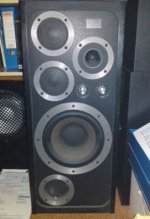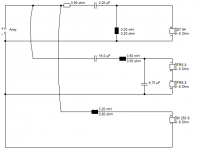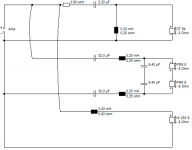Hi all,
I couldn't find a definitive answer to this after searching, so here goes.
My example:
-2 identical 8 ohm woofer drivers wired in series. Each has a Qts of 0.35.
-An Inductor is in series with both of them with a series resistance of 0.6 ohms.
Now I know the Qts doesn't get effected by simply putting them in series, (ie: it remains 0.35) however, what is the effect of the 0.6 ohms on both drivers' individual Qts?
If it was only one driver used it would be 0.6 ohms in series with 8 ohms. Driver Qts becomes APPROX 0.38 (as an example)
But in the above example its now 0.6 ohms in series with two 8 ohm drivers in series. (16 ohms)
What will each drivers Qts become?
Sort of hard to explain but I hope it makes sense.
Any help appreciated.
Thanks.
I couldn't find a definitive answer to this after searching, so here goes.
My example:
-2 identical 8 ohm woofer drivers wired in series. Each has a Qts of 0.35.
-An Inductor is in series with both of them with a series resistance of 0.6 ohms.
Now I know the Qts doesn't get effected by simply putting them in series, (ie: it remains 0.35) however, what is the effect of the 0.6 ohms on both drivers' individual Qts?
If it was only one driver used it would be 0.6 ohms in series with 8 ohms. Driver Qts becomes APPROX 0.38 (as an example)
But in the above example its now 0.6 ohms in series with two 8 ohm drivers in series. (16 ohms)
What will each drivers Qts become?
Sort of hard to explain but I hope it makes sense.
Any help appreciated.
Thanks.
besides the usual tradeoffs series or parallel debates , remember due to the increase in series resistance the inductor value needs to be doubled for the same filtering bandwidth and the increased Rdc and copper costs that comes with that design decision.
theory usually assumes perfect coupling and matched drivers , so theres that to add to the debate. so in practice its not an easy answer. Besides 16 ohm is not ideal for delivering amplifier power.
theory usually assumes perfect coupling and matched drivers , so theres that to add to the debate. so in practice its not an easy answer. Besides 16 ohm is not ideal for delivering amplifier power.
Last edited:
http://www.diyaudio.com/forums/diyaudio-com-articles/158899-arpeggio-loudspeaker.html
Rather good driver calculations there. Let's say coil DCR is 0.3R per driver wired in series.
The Qe= Qes (Re +R / Re). That is Qe (0.3 +6 /6). So Qe increases by 5%. Which near enough, takes Qts up 5% because Qes dominates. Say 0.37 in your case where Qts is 0.35.
Like with this typical driver: H1659-08 U22REX/P-SL
Rather good driver calculations there. Let's say coil DCR is 0.3R per driver wired in series.
The Qe= Qes (Re +R / Re). That is Qe (0.3 +6 /6). So Qe increases by 5%. Which near enough, takes Qts up 5% because Qes dominates. Say 0.37 in your case where Qts is 0.35.
Like with this typical driver: H1659-08 U22REX/P-SL
http://www.diyaudio.com/forums/diyaudio-com-articles/158899-arpeggio-loudspeaker.html
Rather good driver calculations there. Let's say coil DCR is 0.3R per driver wired in series.
The Qe= Qes (Re +R / Re). That is Qe (0.3 +6 /6). So Qe increases by 5%. Which near enough, takes Qts up 5% because Qes dominates. Say 0.37 in your case where Qts is 0.35.
Like with this typical driver: H1659-08 U22REX/P-SL
Ok, I think that answers my question.
So basically, when calculating Qts in this application, the external series resistance is halved for each driver.
Ie: the effective series resistance is 0.3 ohms. (per driver)
Thanks for your responses.
For people who get in a muddle about MT to MTM conversions, it pays to do a thought experiment.
This is a real speaker, the splendid Wharfedale E70 which has twin mids wired in series. In fact the speaker would work with a single mid too on an adjusted crossover with halved and doubled values. But sound different.
Series MTM has the interesting property that although each driver only see half the voltage (-3dB), and hence a quarter of the electrical power (-6dB) each, the sound level on-axis is the same as a single driver due to 3dB gain from twin drivers but a different polar response above and below axis.
The two circuits below are equivalent. You can see what the values would be for a single driver. Ideally you seek a Butterworth BW3 flat power response overall, but LR2 and LR4 are doable, if I haven't gone over your head there.
If both identical drivers are in the same enclosure, of double the size naturally, I think series wiring is better on theoretical grounds. The current each driver sees is the same, so it all works nicely.
This is a real speaker, the splendid Wharfedale E70 which has twin mids wired in series. In fact the speaker would work with a single mid too on an adjusted crossover with halved and doubled values. But sound different.
Series MTM has the interesting property that although each driver only see half the voltage (-3dB), and hence a quarter of the electrical power (-6dB) each, the sound level on-axis is the same as a single driver due to 3dB gain from twin drivers but a different polar response above and below axis.
The two circuits below are equivalent. You can see what the values would be for a single driver. Ideally you seek a Butterworth BW3 flat power response overall, but LR2 and LR4 are doable, if I haven't gone over your head there.
If both identical drivers are in the same enclosure, of double the size naturally, I think series wiring is better on theoretical grounds. The current each driver sees is the same, so it all works nicely.
Attachments
Last edited:
I wouldn't even bother. You just compare the ratio of the driver resistance to the inductor's resistance. The percentage is broadly the increase in Qts.
Any modelling program takes this into consideration, as do all published designs. Qts is usually wildly inaccurate in published data anyway. Like 10-20%. May improve with break-in.
Any modelling program takes this into consideration, as do all published designs. Qts is usually wildly inaccurate in published data anyway. Like 10-20%. May improve with break-in.
I wouldn't even bother. You just compare the ratio of the driver resistance to the inductor's resistance. The percentage is broadly the increase in Qts.
Any modelling program takes this into consideration, as do all published designs. Qts is usually wildly inaccurate in published data anyway. Like 10-20%. May improve with break-in.
It's rather easy to run Boxsim in Windows:
Software | Visaton
Import any design into the projekte folder and off you go:
2 Wege – Boxsim Projektdatenbank
Play away.
Ia there a simple online calculator to show the affects of inductor dcr on driver/system?
XSim will easily do this.
I also have to add, because I did not see it discussed, using a high DCR coil can in fact be a good thing, and help remove the need for a separate baffle step circuit. Somewhere Troels Gravesen discusses doing just this.
Best,
E
In a series circuit all currents are identical, but voltages can vary.
Thus anything that affects current in one driver will also change the current in the other. Each driver's impedance would be unchanged, but you would be introducing a new impedance into the series chain.
Thus anything that affects current in one driver will also change the current in the other. Each driver's impedance would be unchanged, but you would be introducing a new impedance into the series chain.
- Status
- This old topic is closed. If you want to reopen this topic, contact a moderator using the "Report Post" button.
- Home
- Loudspeakers
- Multi-Way
- Inductor series restistance, effect on Qts, 2 identical drivers in series


